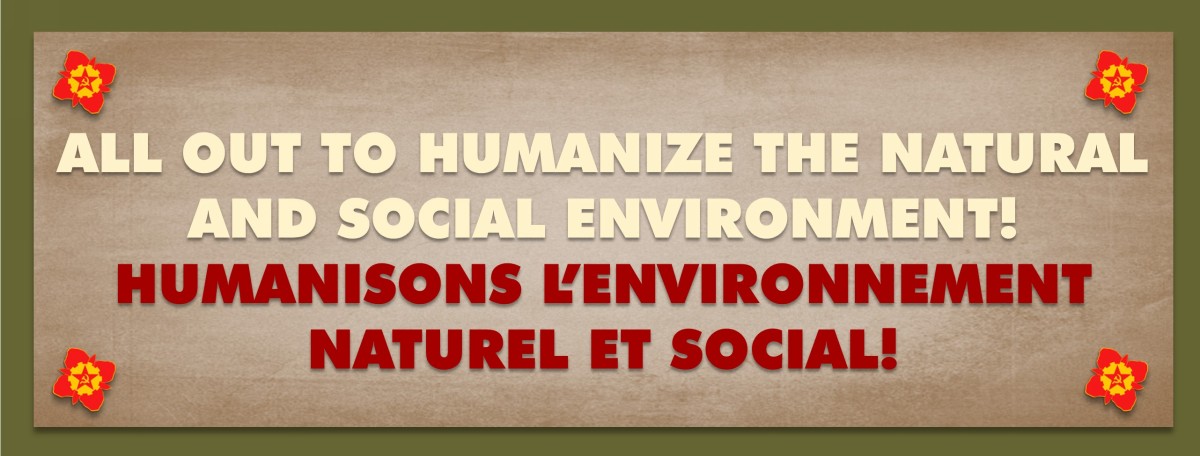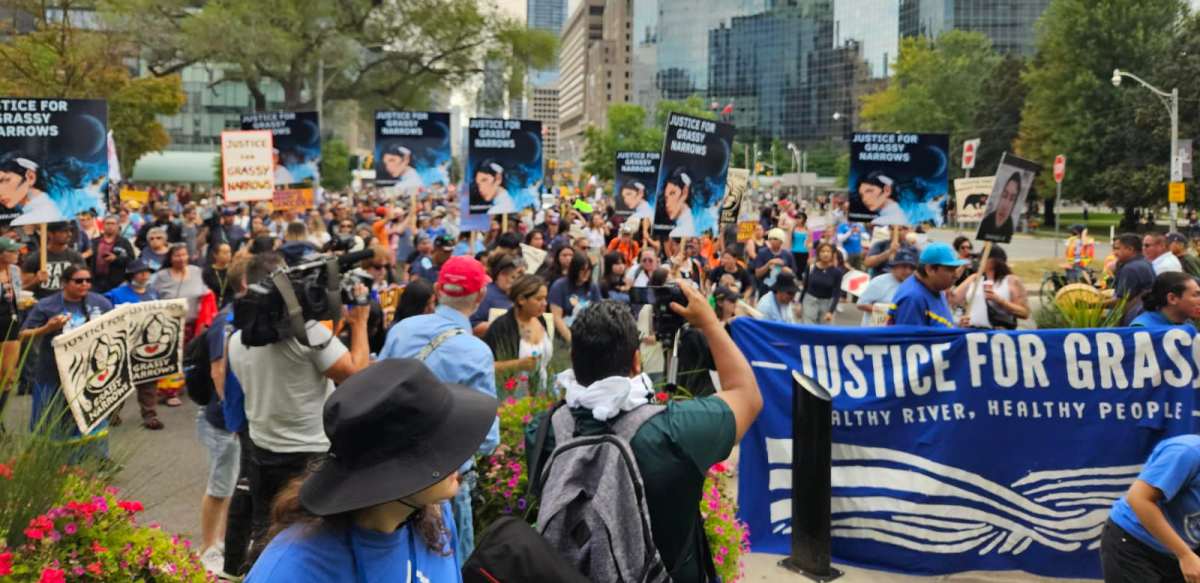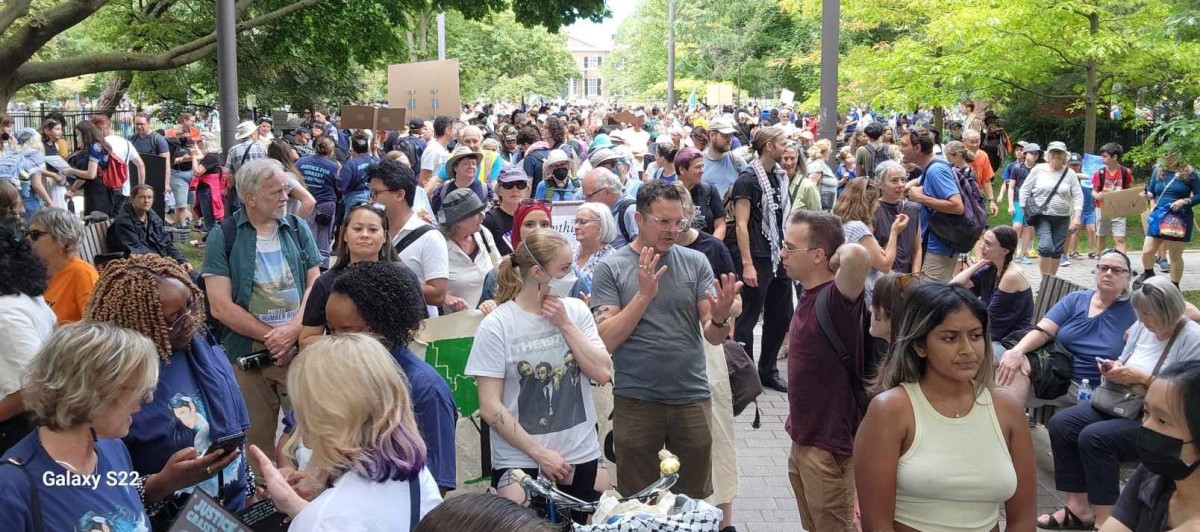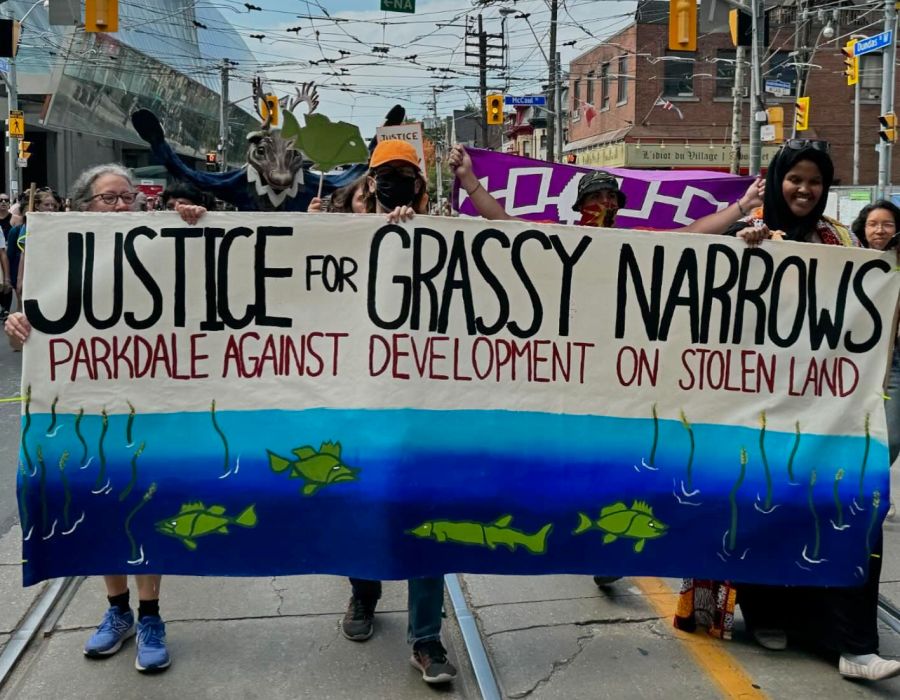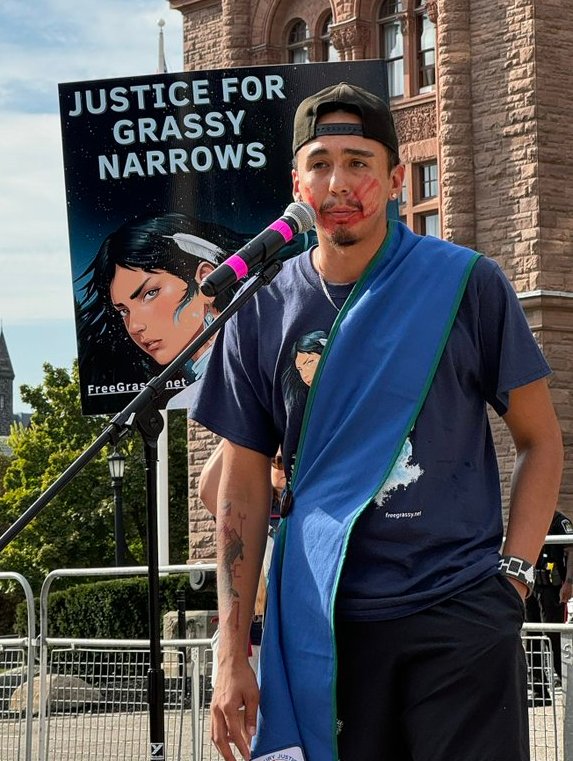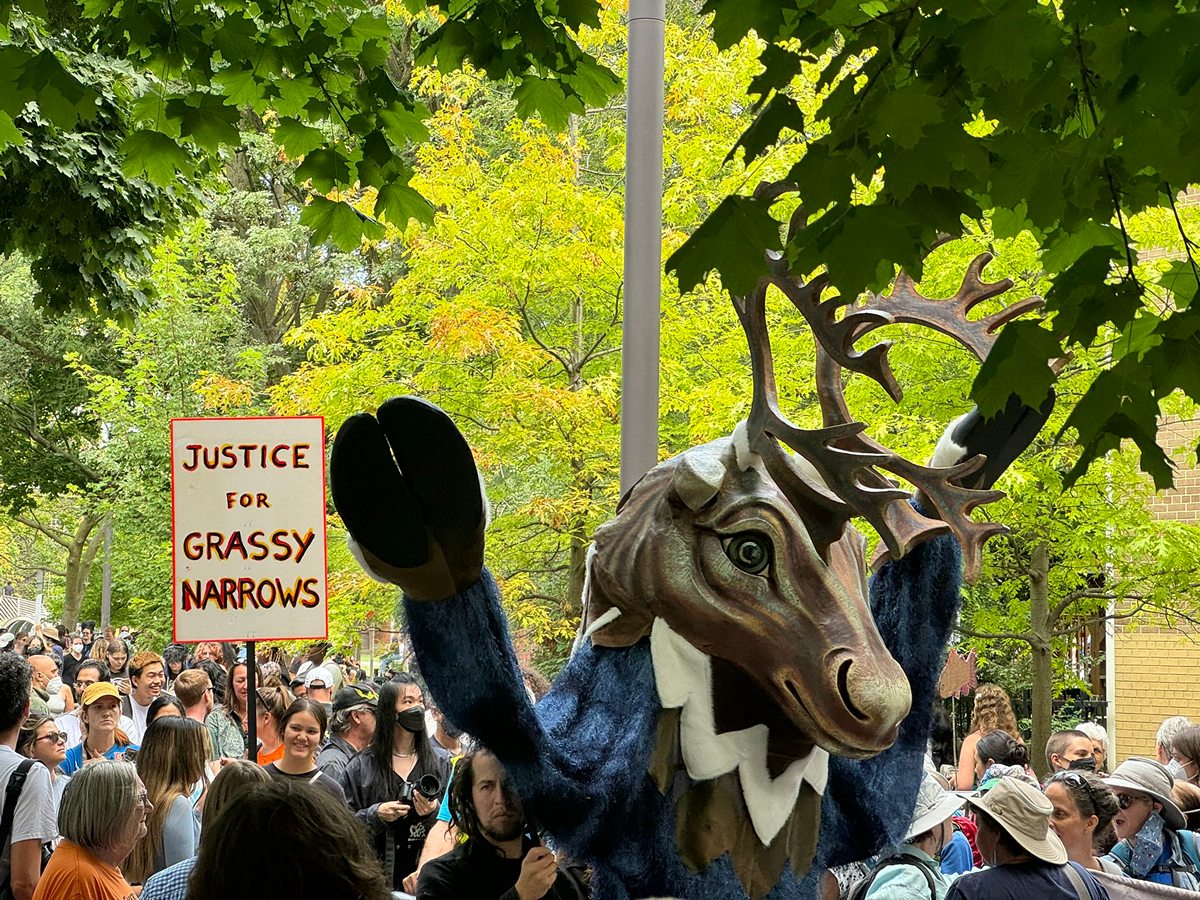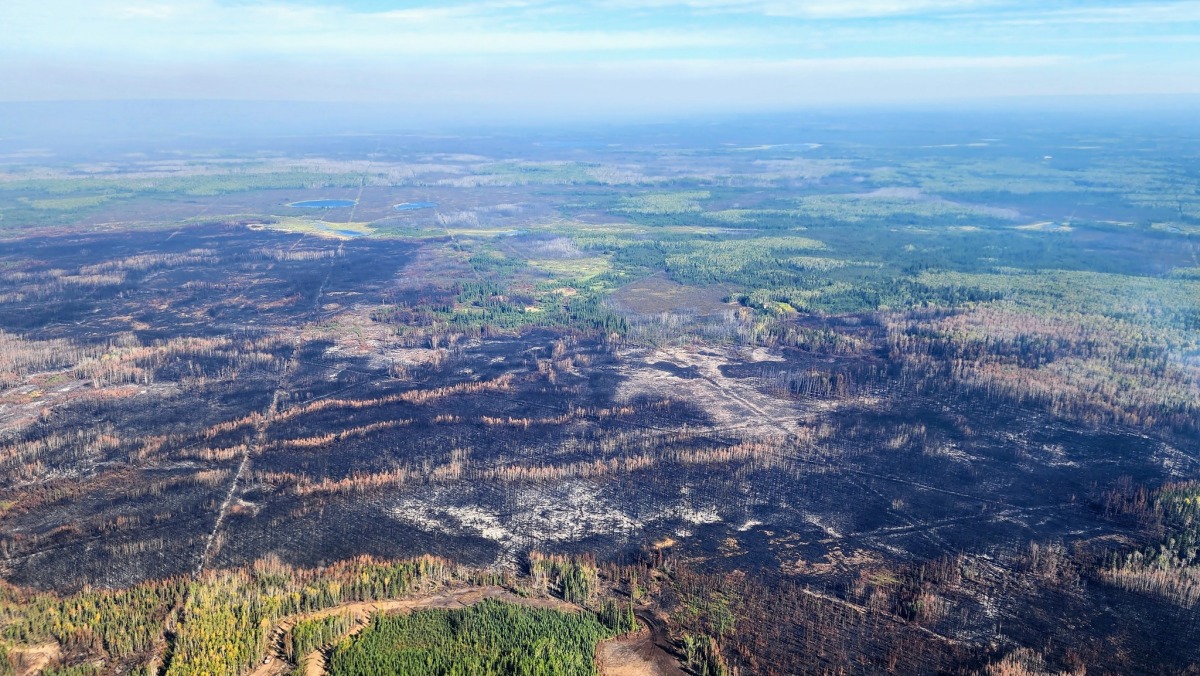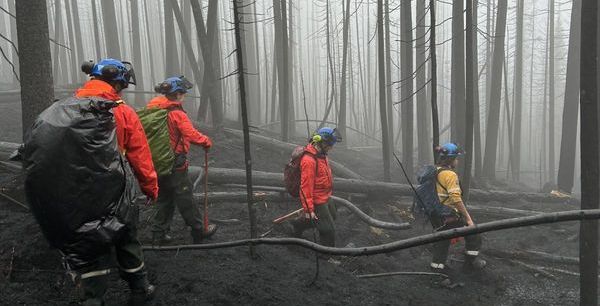September 27, 2024
September 27 – Quebec Day of Action
"So That the World May Go On"
Join In! All Out to Humanize the Natural
and
Social Environment!
• Join In! All Out to Humanize the Natural and Social Environment!
Whose Resources? Our Resources!
• Voice of
Quebeckers Opposed to Graphite Mine Rings Out
Loud and Clear
Pay the Compensation Grassy Narrows Demands!
• Thousands March to Queen's Park to Demand Justice
for Grassy
Narrows
Wildfires –- a Problem of Who Controls Decision-Making in Canada
• Uphold the Right of Indigenous Communities to Exercise Control
Over Their Traditional Territories
• National Indigenous Fire Safety Council Speaks Out on
Deaths from
Fire
• Paying Respect to the Firefighters Who Have Died
September 27 -- Quebec Day of Action
"So That the World May Go On"
Join In! All Out to Humanize the Natural
and
Social Environment!
CALENDAR OF EVENTS
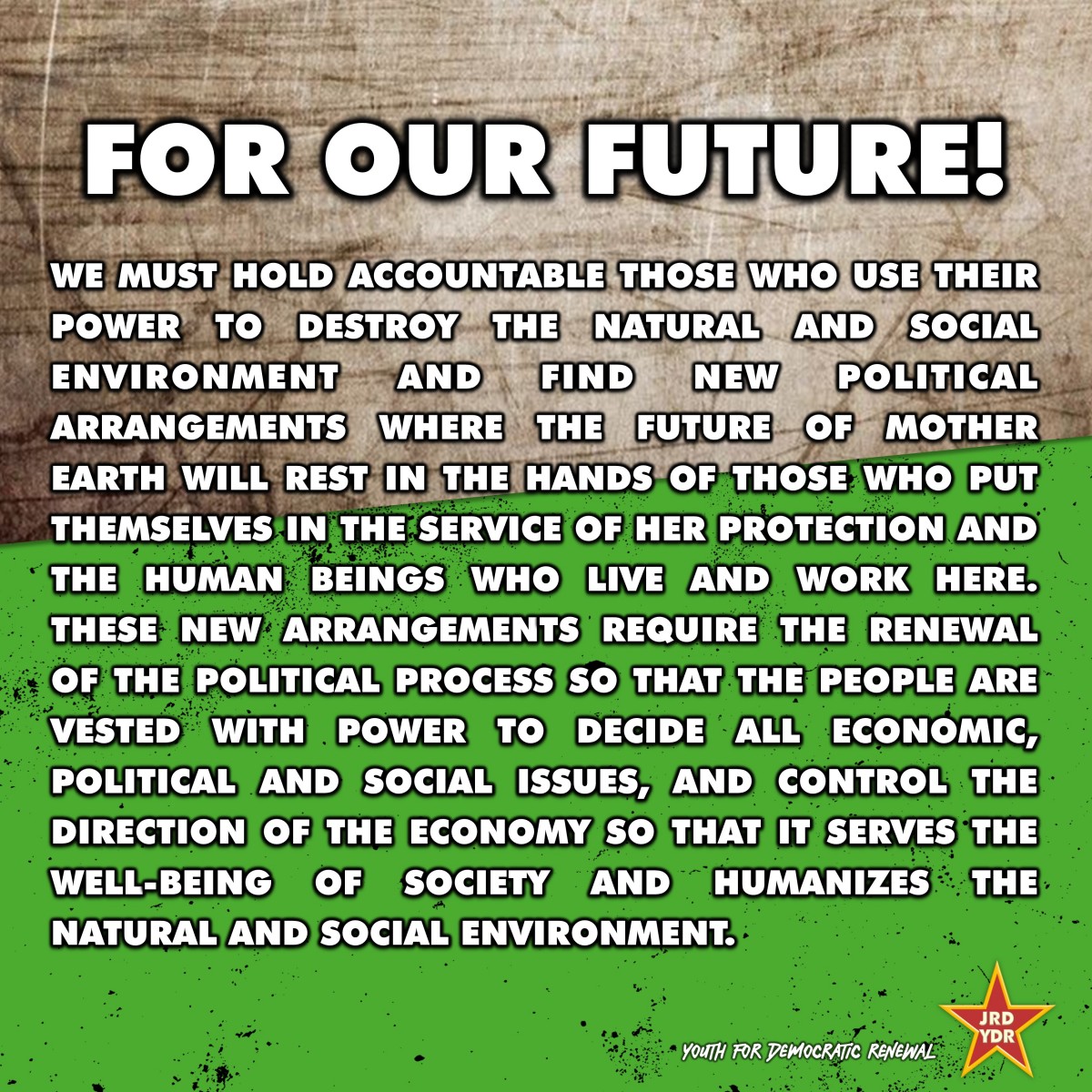 The organization Pour la suite du monde (So That the World May Go On)
has issued a call for mobilizations across Quebec on September 27 to
demand concrete action for social and environmental change. The
organizers point out that governments must assume their
responsibilities, and implement solutions
proposed by the people for the problems they face for genuine social
and environmental change.
The organization Pour la suite du monde (So That the World May Go On)
has issued a call for mobilizations across Quebec on September 27 to
demand concrete action for social and environmental change. The
organizers point out that governments must assume their
responsibilities, and implement solutions
proposed by the people for the problems they face for genuine social
and environmental change.
CPC(M-L) calls on everyone to join the actions on September 27. Already across the country it is Canadians and Quebeckers from all walks of life who have taken up the work to humanize the natural and social environment. By laying claim to the resources which belong to them as citizens and residents of the country by virtue of the fact that they are the producers of all the wealth the society depends on to sustain itself, they have the right to be the decision-makers when it comes to how the natural resources are disposed of and who benefits. The fight to ensure the well-being of Mother Earth by setting the direction of the economy on a human-centred basis and removing Canada and Quebec from the U.S. imperialist war chariot is the key to making sure the world goes on!
Whose Resources? Our Resources!
Voice of
Quebeckers Opposed to Graphite Mine
Rings Out Loud and Clear
Quebeckers are categorically opposed to the project to open a graphite mine in the Laurentians north of Montreal. Lomiko Metals Inc., a mining company based in Surrey, BC, announced plans for a mine called La Loutre and received $11.4 million from the United States Department of Defense (Pentagon) for the project.
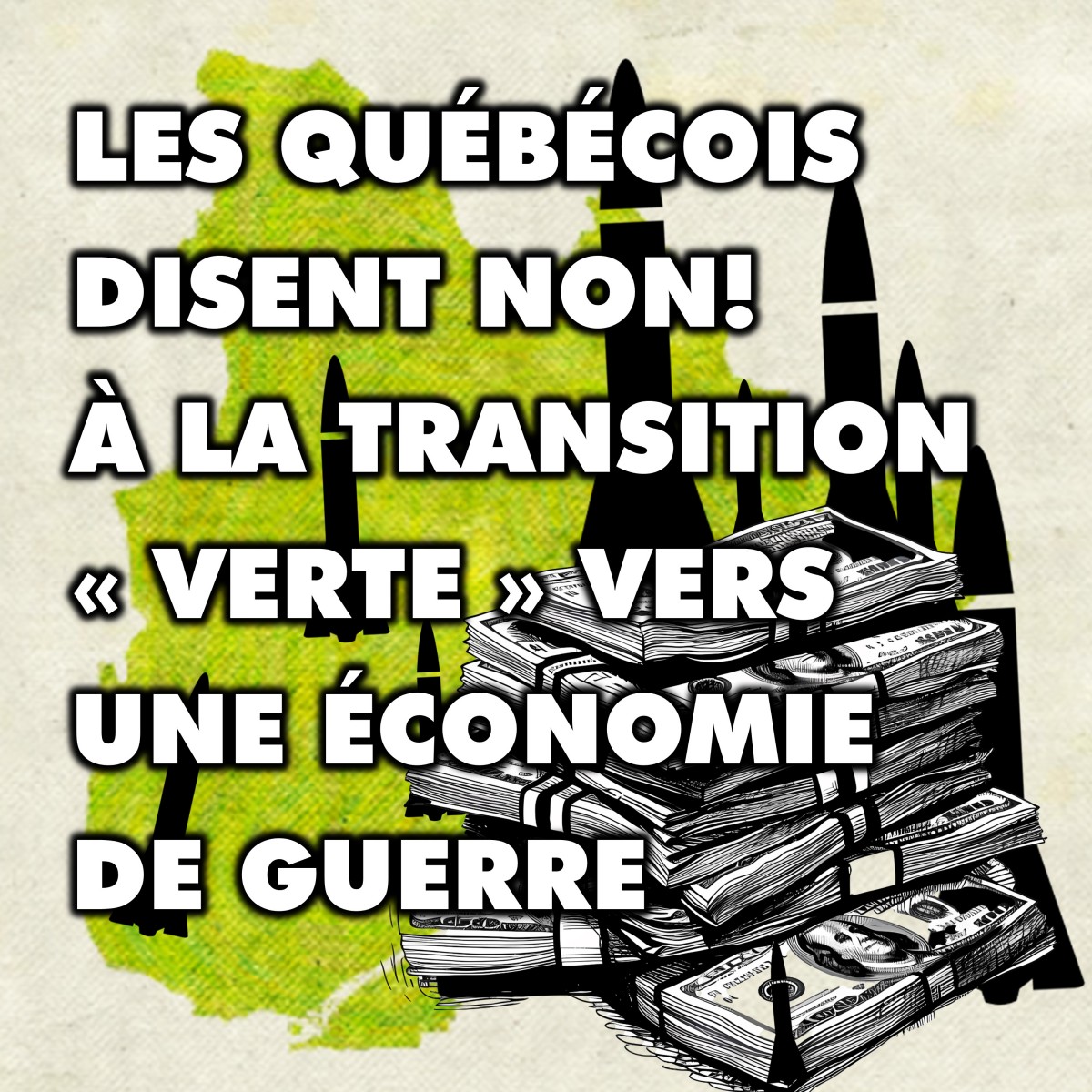 The
citizens and residents of five Quebec municipalities located near the
proposed site for the graphite mine have organized to stop this
project. The people who live in Duhamel, Lac-Simon,
Chénéville, St-Émile-de-Suffolk and Lac-des-Plages
have taken charge of informing the public because the government has
been negligent in holding public hearings. They have been holding
public consultations and demand that the provincial government listen
to what they have to say. On August 25 at a public information session
in Chénéville the alliance of these municipalities
announced that a referendum on the project will take place on November
2, 2025.
The
citizens and residents of five Quebec municipalities located near the
proposed site for the graphite mine have organized to stop this
project. The people who live in Duhamel, Lac-Simon,
Chénéville, St-Émile-de-Suffolk and Lac-des-Plages
have taken charge of informing the public because the government has
been negligent in holding public hearings. They have been holding
public consultations and demand that the provincial government listen
to what they have to say. On August 25 at a public information session
in Chénéville the alliance of these municipalities
announced that a referendum on the project will take place on November
2, 2025.
Graphite is promoted as being one of the world's most sought after minerals needed to provide "green energy" solutions to the climate crisis. It is used, besides other things, to manufacture electric vehicle batteries. Graphite is not only used in lithium-ion batteries. It is also a key material in energy storage, pencils, sporting equipment and electronics, which includes smartphones and laptops. The graphite market is projected to hit $27 billion by 2025, with the demand for the material increasing in multiple industries.
The Lomiko Metals' website has this to say about "The Need for Graphite:"
"The world is waking up to the reality that the way we consume fossil fuels for energy is having an adverse impact on our planet. Alternative and clean forms of energy generation and storage are being developed at a rapid rate, and the movement includes the electrification of consumer cars and other vehicles that have up until now been fueled by gasoline.
"As the demand for electric cars grows and more automotive manufacturers offer them, they are becoming more affordable, which is having a profound effect on the consumer vehicle industry. To manufacture the large, complex batteries required to power electric vehicles, four metals are required: lithium, cobalt, nickel and graphite. There is 15x more graphite in electric car batteries than lithium, making it a key component of the movement.
"With fuel prices surging and the need for eco-friendly alternatives becoming a necessity, graphite will play a pivotal role in the electric vehicle industry in years to come.
"Up until now, China and Mozambique have been the predominant sources for graphite across the world. With deposits coming from so far away, the North American markets have struggled to justify the import prices. However, with Lomiko Metals' La Loutre deposit in Quebec, Canada, North American-sourced graphite has now become a viable option for prominent consumer vehicle companies."
This is typical market speak to disinform the public. What is key is what is missing – that these resources belong to the people and it is up to the people to decide what if anything is to be done with them. People are key. The relations they enter into are key. How they make their living, generation after generation, what happens to the lands they live on, to the well-being of both their lands and their children and families -– this is what is key.
Louis Saint-Hilaire, president of a local environmental group, told one of the first public consultation meetings in July:
"We don't want to have a gigantic open pit mine in the middle of all those lakes and all those people living around them." Few local people support the project, he said, especially after Lomiko announced in May it received a grant of $11.4 million from the Pentagon. "People are furious about this," he said.
What is also significant is the fraud committed by the narrow private interests and the governments promoting these projects. Governments use prerogative ministerial powers to circumvent environmental assessments, criminalize citizens who speak out, ignore them, lie about the benefits, lie about the aim to enrich private interests, integrate the economy to the U.S. war economy and everything else.
While mining of critical minerals is promoted as part of getting rid of fossil fuels and "greening" the economy this is a fraud. The problem is not 'fossil fuels' per se but who makes the decisions and in whose interests. Sold out individuals who are part of the cartel party system of government, members of legislative assemblies and the federal parliament who benefit from their positions of power and privilege, are part of a decision-making process which excludes the citizens of this country. They are yes-men and yes-women for governments which support genocide and wars of destruction and sustain the impoverishment of the peoples of the whole world. Because of the rule of narrow supranational private interests the peoples of the world, including Canada, suffer. Wars of destruction, genocide, droughts, climate crises, famines, mass migrations of people escaping untenable conditions and so on are because of the power structures, who controls the decision-making and who the decisions benefit.
When purified, the metal lithium is highly reactive and flammable. Lithium-ion batteries can become a source of ignition due to manufacturing defects, degradation over time, damage or improper disposal. Under such conditions, lithium-ion batteries have caused very dangerous fires which are difficult to extinguish, emit toxic smoke and cause great harm to human beings. One such fire recently took place in the Port of Montreal on September 24 when a shipping container holding some 15,000 kilograms of lithium batteries caught fire around 2:45 pm. It took the Montreal Fire Department until 3:15 am to put it out. A lockdown was declared because of the danger posed to the inhabitants of the area but people had nothing to protect them from the toxic fumes, no explanations of what was happening, no control over their lives and possessions.
Besides the dangers to which the citizens and residents of this country are subjected, with no recourse whatsoever, they know full well that these projects have nothing to do with safeguarding the natural environment and everything to do with the U.S. war economy and justifying the give-away of public funds to narrow private interests. There is absolutely no benefit to the people of this country, their well-being or livelihoods.
Of greatest significance to Canadians and Quebeckers is to see how their fight, all of them together, makes a difference. The united voice of the people is putting a spoke in the wheels of the destructive war chariot governments are propelling. It is showing the people of the country what is really taking place and the extreme measures to which governments are resorting to silence the truth of matters and to cover up their their fraud and corruption. Some projects have been forced to close down, thanks to the peoples' battle against them. In the case of the Wet'suwet'en in BC, the keepers of the land are being assaulted by the only militarized RCMP unit in the country, facing criminal charges and imprisonment for defending themselves and their land. These battles waged by Canadians from all walks of life and Indigenous land defenders deserve the support of all.
It is the human factor/social consciousness which is decisive, the working people speaking out on their own behalf, digging into the truth of the matters at hand, exposing the fraud and shaming the sell-out politicians, especially the "top guns" the federal and provincial governments are paying fortunes to commit fraud.
Notes
1. Lomiko Metals has said it will be conducting feasibility and metallurgical studies over the next five years and will be subject to a review by Quebec's environment consultations office, known as the BAPE. It says it plans to begin construction by 2027.
2. Graphite is a key mineral for manufacturing military equipment. A 2023 report by The Hague Centre for Strategic Studies, a defence and security think tank based in the Netherlands, lists graphite as a critical mineral whose supply chain is under threat. The report said European militaries need graphite for fighter aircraft, battle tanks, submarines, artillery and ammunition.
In a statement, Lomiko chief sustainability officer Cindy Valence told the Canadian Press that the company has already met with "a multitude of stakeholders" and will "follow all government processes as a responsible operator in the critical minerals sector."
The company will continue to share the results of water quality testing with the community and seek local feedback on other issues including road access, according to Valence, who added that the mine will create jobs and help Quebec meet its critical minerals strategy objectives.
The office of Quebec Minister of Natural Resources Maïte Blanchette Vézina said, "it is important that the mining projects that go forward in Quebec generate social acceptability in the communities concerned."
In a separate statement, the Natural Resources Department said it requires companies seeking mining leases to receive authorization under Quebec's Environment Quality Act, a process that generally involves consulting the BAPE.
"To ensure that a mining project integrates into its host environment, developers are strongly encouraged to set up mechanisms for dialogue with communities very early on in the development of their project," the department said.
However, Rodrigue Turgeon, national program co-lead at Mining Watch Canada, says it can take years for the BAPE to make an impact assessment, long after mining companies have begun promising jobs and centering the debate on economic development at the expense of environmental considerations.
Furthermore, what defines social acceptability remains murky.
"There are no specific guidelines in the [Quebec] Mining Act, nor in any other laws in Quebec at the moment to define social acceptability," said Turgeon.
Pay the Compensation Grassy Narrows Demands!
Thousands March to Queen's Park to Demand
Justice for Grassy
Narrows
Thousands of people took part in the Seventh River Run rally on September 18 to demand that the federal and provincial governments compensate the Ojibwe people of the Asubpeeschoseewagong (Grassy Narrows) First Nation, for the ongoing mercury pollution of the Wabigoon River system, end industrial development on the Grassy Narrows territory and respect the traditional way of life of the people.
The action began at noon in Grange Park behind the Art Gallery of Ontario. After thanking people for their decades-long support, Grassy Narrows First Nations Chief Rudy Turtle said that his people's struggle for justice has been long and hard but that they are determined to fight for their hereditary and treaty rights. "We are not going away. As long as the sun shines, as long as grass grows, as long as the river flows, we will remain Grassy Narrows First Nation," he said.
Between 1962 and 1970 the Dryden paper mill dumped 10 tons of mercury into the Wabigoon River 100 kilometres upstream from the Grassy Narrows First Nation, a community of some 2,000 people. The mercury poisoning has had a catastrophic impact on the community and has led to increased rates of birth defects, heart and lung diseases, and a mental health crisis in the community. A recent study indicated that 90 per cent of the residents of Grassy Narrows suffer the effects of mercury poisoning.
A study this past May found current sulphate emissions from the paper mill near the community are exacerbating the impact of the mercury in the river system. Neurotoxins from the accumulated poisons have adversely affected the health of the people as the fish and wildlife of the area that depend on the Wabigoon River system have been contaminated. Additionally both the federal and provincial governments have greenlit industry and mining development against the wishes of the people.
In June, Grassy Narrows First Nation sued the federal and provincial governments accusing them of allowing the Wabigoon River to be polluted and then refusing to remediate it while serving the interests of private mining and industry. This is a violation of the treaty obligations of the governments at both levels to ensure the health of the fish stock which is staple in the diet of the Grassy Narrows people. No statements of defence have yet been filed by either government.
Participants of all ages, many from Grassy Narrows First Nation, marched to Queen's Park where more speeches were made and a giant 1,600 square foot banner reading "Justice for Grassy Narrows" was unfurled. Union leaders including Fred Hahn, President of the Ontario Division of the Canadian Union of Public Employees, and other speakers decried the neglect and inaction of governments to ensure the well-being of the people of Grassy Narrows, and affirmed their continued support for their just demands.
(With files from Grassy Narrows First Nation, Toronto Star)
Wildfires -- a Problem of Who Controls Decision-Making in Canada
2024 "Wildfire Season"
As of September 21, 5,236 wildfires have been reported in Canada in 2024, with a total area burned of 5.4 million hectares (54,000 sq. kms). This is greater than 1.5 times the size of Vancouver Island. With "the season" still in progress, the area burned to date is almost twice the historical average of 2.5 million hectares, or 25,000 square kilometres. The Northwest Territories had the largest area burned at 1.67 million hectares (mha), followed by BC with 1.06 mha, Saskatchewan with 0.976 mha and Alberta with 0.708 mha. One hundred hectares equals one square kilometre.[1]
Indigenous Peoples, who represent five per cent of the population, are disproportionately affected by wildfires, as First Nations communities account for 42 per cent of evacuees. Thousands of Indigenous people had to evacuate this summer in BC, the Northwest Territories and across the Prairies, many from remote communities in the north.
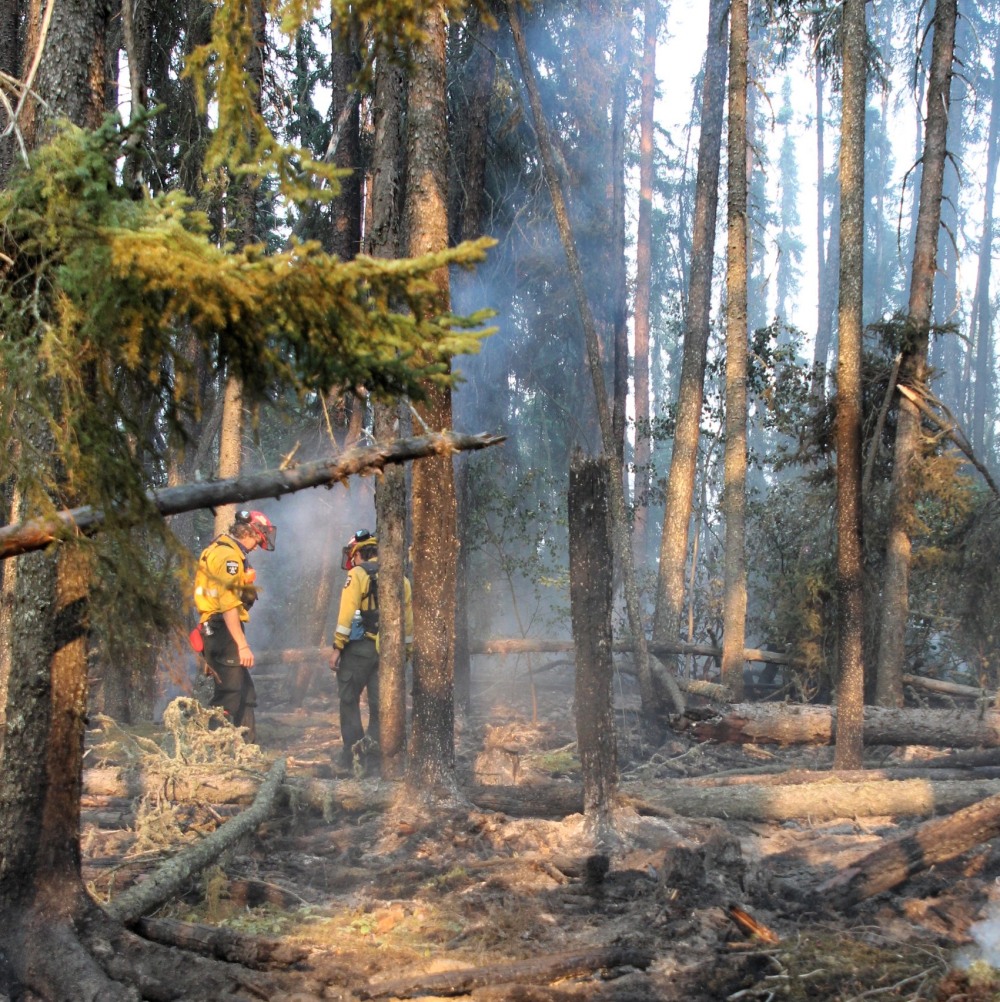 Prior
to this, Canada's 2023 "wildfire season" was the most destructive ever
recorded, with more than 6,000 fires in total which burned a staggering
15 million hectares of land. This was more than six times the
historical average.[2] According to NASA scientists,
these fires released about 640
million metric tons of carbon. That's comparable in magnitude to the
annual fossil fuel emissions of a large industrialized nation.[3]
Prior
to this, Canada's 2023 "wildfire season" was the most destructive ever
recorded, with more than 6,000 fires in total which burned a staggering
15 million hectares of land. This was more than six times the
historical average.[2] According to NASA scientists,
these fires released about 640
million metric tons of carbon. That's comparable in magnitude to the
annual fossil fuel emissions of a large industrialized nation.[3]
Boreal forests regenerate through fire, but the science tells us that the wildfires of today are not consistent with the pattern of regeneration they require. While the traditional cycle of burn and regeneration is about 100 years, the fires in 2023 alone burned more than 10,000 square kilometres of forest that had already burned within the last three decades. Deciduous forests which are usually more resistant to wildfires also burned.
A report from Natural Resources Canada states, "This disturbance has the potential to cause extensive post-fire tree regeneration failures, because immature trees cannot provide enough seeds following a fire." The report also states that in Quebec, more than 3,000 square kilometres of commercially harvested forest is now vulnerable to "regeneration failures." This amounts to between 300,000 and 400,000 hectares (3,000-4,000 square kilometres) of forests.[4]
Another concern is the long, slow burn of peatlands where fire can go deep into the earth and burn for months or even longer. Peatlands store close to a third of the total carbon found in soils worldwide, and Canada has 25 per cent of the world's peatlands or peat bogs. These fires are very difficult to extinguish which threatens their enormous contribution to carbon sequestration and raises more concerns that regeneration will fail in these forests.
Blame falls on the forest monopolies which pursue numerous practices which are extremely harmful, including clear-cutting, destruction of old growth forests, "reforestation" based on monoculture, the use of pesticides to get rid of "undesirable" less profitable species such as birch and elder, and logging of the oldest trees which scientists have shown play a key role in the success of forest regeneration. The result is unhealthy forests, failed reforestation, and the increased size and ferocity of wildfires, endangering communities and literally adding fuel to the fire of the climate crisis.
Logging and forestry, pulp and paper, and wood-products manufacturing employ around 202,000 workers across the country, with the majority in BC and Quebec. The future of the forests, of the workers and their communities and that of the Indigenous nations and Métis living in the forest, cannot be left to the whims of the mainly U.S. forest monopolies. Governments do their bidding and permit them to continue their reckless practices. The damage caused and the grave threat they pose is not discussed.
Speaking about the threats to regeneration, a study of the 2023 wildfire season in Canada published in Nature Communications states, "These failures, compounded by logging legacies, drought, and insect outbreaks, could reduce forest productivity and carbon stocks, and accelerate the transition from boreal forests to open taiga, prairies or parklands. Forest landscape changes from the 2023 wildfire season will have profound effects on forest ecosystem processes and biodiversity, with species adapted to early-stage or open-canopy forests benefiting, whereas those reliant on mature or old-growth forests being most negatively affected in the near term. The cumulative impacts of the area burned in 2023 coupled with the extensive anthropogenic disturbance legacies on the landscape will challenge the resilience of forest ecosystems, especially if fire activity continues to increase, as projected."[5]
Humanizing the social and natural environment requires eliminating the control of the forestry industry and other sectors of the economy by narrow private interests whose aim is only to enrich themselves. They continue to do whatever they can get away with. They deny the experience of Indigenous firekeepers, scientists and forestry workers as well as firefighters. This is a fight which concerns everyone and which the youth in particular continue to wage along with members of communities across the country. The need for the working class and people to exercise decision-making power and control is immediate.
Notes
1. Canadian Wildland Fire Information System.
2. Canadian Interagency Forest Fire Centre 2024.
3. Study, published on August 28 in the journal Nature, led by scientists at NASA's Jet Propulsion Laboratory in Southern California.
4. Canada's record-breaking wildfires in 2023: A fiery wake-up call.
5. Drivers and Impacts of the Record-Breaking 2023 Wildfire Season in Canada, published in Nature Communications.
Jasper Wildfire
The town of Jasper, Alberta in Jasper National Park and the park itself experienced a devastating fire this summer. The Jasper Wildfire Complex, formed when fires to the north and south of the town and the Utopia wildfire near Miette Hot Springs merged, spanned more than 33,000 hectares and impacted the town of Jasper, outlying visitor accommodation and various Parks Canada facilities. More than 20,000 people including 5,000 residents were evacuated safely from the park and town from July 22-24. Jasper is the largest national park in the Canadian Rockies and is known worldwide for its spectacular beauty, abundant wildlife and extensive trail network.
The fire was unprecedented in its ferocity and destroyed 30 per cent of all buildings in the town. Firefighters reported witnessing 300-400 foot flames. "There is nothing any human on earth, or any piece of equipment, could have done standing in front of that wall of fire that would have allowed them to stop it. It's just not possible," Ron Hallman, Parks Canada president and CEO said. The Herculean efforts of firefighters and other essential workers saved the remainder of the town, and on August 17 the Jasper Wildfire Complex was classified as being held and the Evacuation Alert lifted from the town. The people of Jasper are now coping with the devastation and beginning the recovery, determined to rebuild their beloved town, a historic railway town. A message posted on social media by the Municipality of Jasper on August 22 stated, "Jasper's spirit is unshakable. We honour the resilience of our community and the tireless efforts of those, from here and away, who have worked to protect and restore it. From the bottom of our hearts: Thank You."
Our hearts go out to all affected by the fire which consumed so many homes and businesses, and to the firefighters who risk their health and lives. Those affected include approximately 1,500 temporary foreign workers who have been left in limbo, as their work permits are tied to one employer. Community organizations have stepped forward to assist them, while the federal government has shown its indifference, will not provide open work permits and has only announced that it will not charge the workers when they apply for new work permits.
The devastating fire in the town and park has raised many questions. National parks are said to be kept in their natural state, while the truth is that before it was declared a national park, the land was home to the Anishinaabe, Aseniwuche Winewak, Dene-zaa, Nehiyawak, Secwepemc, Stoney Nakoda, and Métis. They were forcibly removed and blocked from accessing their territory, and with them their deep knowledge of how to live with fire and to use fire "in a good way" was also banished.
Parks Canada fire specialists and firefighters have carried out a lot of work to protect Jasper, Banff and towns in parks across the country. Forests have been thinned, controlled burns have been used since 1996, and a FireSmart program has been in effect since 2003. Increasing the danger of wildfires, a mountain pine beetle infestation has left hundreds of thousands of hectares of forest precariously dry.
Because it is situated in a national park, Jasper was better equipped than many communities in the forest across the country, especially Indigenous communities, to fight the fire. Many people are asking -– if fire cannot be controlled in a national park with more extensive resources, what is the future of other communities in the forest? Alberta Premier Danielle Smith was quick to seize the "opportunity" to advocate clear cut logging by private timber companies. "We've got forest management agreements with all of our forestry companies," Smith said. "There's no reason why we can't say, 'Hey, guess what? Can you prioritize cutting here? Can you prioritize building fire breaks in this way?"'
Certainly more resources are required to mitigate the consequences of global warming which is compounded by 100 years of fire suppression which have resulted in aging forests which burn hotter and faster than ever before. Premier Smith's statement is further confirmation that what is key is that those with expertise -– the Indigenous Peoples, the firefighters, the forest scientists, and the communities in the forest must have the decisive say, not the U.S. lumber barons whose only interest is the accumulation of private wealth and whose control poses a grave threat to the future of the forests, the workers in the wood industry, the firefighters, and the communities in the forests.
Uphold the Right of Indigenous Communities to Exercise Control Over Their Traditional Territories
Indigenous communities make up approximately 42 per cent of evacuations due to wildfires but only make up only five per cent of people living on Turtle Island. During the 2023 fire season, by July, 106 wildfires had affected 93 First Nations, leading to 64 evacuations and impacting nearly 25,000 people. Not only have many homes been lost to fire, but displacement from their homes and communities deprives Indigenous and Metis peoples of their livelihood, food sources, and cultural practices. They may return home to find they homes have been destroyed and to a devastated landscape, impacting hunting and gathering of food and medicine from their traditional territory.[1]
Many wildland firefighters in Canada are members of the Indigenous and Métis nations, and risk their lives fighting wildfires. Yet their communities, which are often remote, have difficulty accessing basic goods, services, and other resources that are necessary for mitigating and building resilience against the impacts of wildfires, and even for fighting fires which threaten their community.
Wildfires have serious effects on the health of Indigenous Peoples. Wildfire smoke is strongly associated with an increase in all-cause mortality, Canada's Public Health Agency has found, as well as death from respiratory and cardiovascular disease, exacerbations of asthma and chronic obstructive pulmonary disease (COPD) and in reproductive and development difficulties such as babies born with low birth weight.
Immediate measures which the Indigenous nations are demanding require provision of fire-fighting equipment to the communities, full mobilization of the Indigenous firefighters, and immediate action to contain fires before they threaten communities. They are also calling for permanent, year-round Indigenous Guardian positions in Indigenous communities and other measures to fully restore their ability to exercise decision-making in accordance with their role as stewards of the land and the knowledge and practices acquired from thousands of years learning to live with fire in the forest.
Across BC and the prairies, and in the Northwest Territories, there have been many evacuations during the 2024 fire season involving tens of thousands of people from First Nations communities.
Northwest Territories
Up to September 18, in the Northwest Territories, there have been 171 fires. The total area burned is 1,671,421 Ha.
Alberta
In Alberta, Little Red River Cree Nation was forced to evacuate for the second year in a row. The nation has about 5,500 members, and is made up of three communities: Garden River, Fox Lake and John D'Or Prairie, located about 560 kilometres north of Edmonton. Evacuations were ordered for Garden River on July 10 and John D'Or Prairie and Fox Lake on July 20. Last year, Fox Lake lost more than 200 structures, including 100 homes, a grocery store, and a water treatment plant. The Fox Lake reserve is accessible only by barge in the summer, which is affected by water fluctuations, and by ice road in the winter. This makes bringing supplies to the community difficult, and around 525 people have been living in hotel rooms in High Level and Fort Vermilion, rented accommodation, camps and tiny homes in Fox Lake since 2023 waiting for their homes to be rebuilt.
Saskatchewan and Manitoba
More than 3,800 people from First Nations in Saskatchewan and Manitoba have been forced from their homes by wildfires this year.
In response to the Flanagan fire in Saskatchewan which began in early July, the Saskatchewan Public Safety Agency (SPSA) made the situation more difficult by failing to activate First Nations firefighters. Chief Peter Beatty and the Prince Albert Grand Council (PAGC) released a statement on August 14 informing that the SPSA failed to approve the activation of hundreds of First Nations firefighters that could help extinguish the fires before they become a problem. "Why would you let a fire go that's close to a community until it becomes a huge problem and then try and manage it; at that point, it's unmanageable," Beatty told CBC. He referred to the province's wildfire management as a "let it burn" policy. "There are hundreds of qualified First Nations firefighters ready and willing to assist, but the SPSA has refused to hire them, claiming it is too dangerous. Their reasoning? A lack of proper personal protective equipment,'' the statement said.
Other communities have been threatened during this fire season as well. Prince Albert Grand Council Chief Brian Hardlotte called the province's approach to fire management inadequate and negligent in its disregard for Indigenous communities in northern Saskatchewan, a situation which has existed for the past two decades, he said.
"This isn't just a policy failure, it's a failure of leadership and moral responsibility of the provincial government. Prioritizing economic considerations over human lives and environmental protection is both short-sighted and dangerous," Hardlotte said. "These aren't just remote forests. They are our homes, our sacred lands, and our future. To let them burn without doing everything possible to extinguish the flames is an unforgivable betrayal of our trust," he said.
Around 2,400 members of the Bunibonibee Cree Nation (formerly known as Oxford House) in northeastern Manitoba, were forced to evacuate in August. Bunibonibee Cree Nation is about 577 km north of Winnipeg, and about 185 km southeast of Thompson. People were being evacuated by small passenger planes and a military Hercules jet. The lack of Cree Speakers in the evacuation crews has made the evacuation even more difficult for many who only speak Cree, Chief Hart said. Chief Hart said he had never seen anything like this fire. The combination of dry trees close together and strong winds led to "explosive growth" of the fire.
Indigenous peoples are the traditional guardians and stewards of the land. They know what is needed. The problem lies with the refusal of the Canadian state to recognize Indigenous sovereignty and nation-to- nation relations.
Note
1. Rapid Review: An intersectional analysis of the disproportionate health impacts of wildfires on diverse populations.
(With files from CBC, Global News, Saskatoon Star-Phoenix.)
National Indigenous Fire Safety Council
Speaks Out on Deaths from
Fire
The lack of fire-fighting resources in Indigenous communities does not just lead to the destruction of homes and communities from wildfires. People from the Indigenous communities, particularly First Nations and Inuit, accounted for higher fire-related deaths in Canada between 2011 and 2020 compared to non-Indigenous people, according to a new StatsCan report commissioned by the National Indigenous Fire Safety Council (NIFSC).
About 2,200 fire-related deaths occurred in Canada from 2011 to 2020 in total, according to the Canadian Coroner and Medical Examiner database. Of the 700 victims who could be identified by the researchers, 140 or one in five came from Indigenous communities, while, according to the 2016 census, Indigenous people make up only about 4.6 per cent of the population of Canada.
The report also confirmed what Indigenous Peoples know, that despite the declarations, "apologies," vows to "do better" and so on which emanate from governments, very little has changed over the years. Arnold Lazare, the deputy chief of operations for NIFSC and an experienced firefighter, told the Hill Times that the report confirmed what they have known for years.
"In effect, you have a perfect storm, because you have overcrowded houses that need repairs and are not built to any standards, with a lack of smoke detectors and no fire education and they are in rural areas where fire response is much delayed," he says.
NIFSC's key focus is fire prevention and education, which Lazare believes is the first line of defence in this situation. The NIFSC, he adds, is about to enter into an agreement with the federal government to receive 2,500 smoke alarms to this end. But such measures do not address the housing crisis, both the lack of housing and the need for repairs and renovations. Indigenous and Métis communities across the country have also lost homes to wildfires, compounding the problem of inadequate or no housing.
Lazare also called on the federal government to resume tracking fire-related deaths on reserves, which it stopped doing in 2010. "My guess is that they stopped it because they didn't like the numbers, and it raised questions of accountability," he said.
Paying Respect to the Firefighters Who Have Died
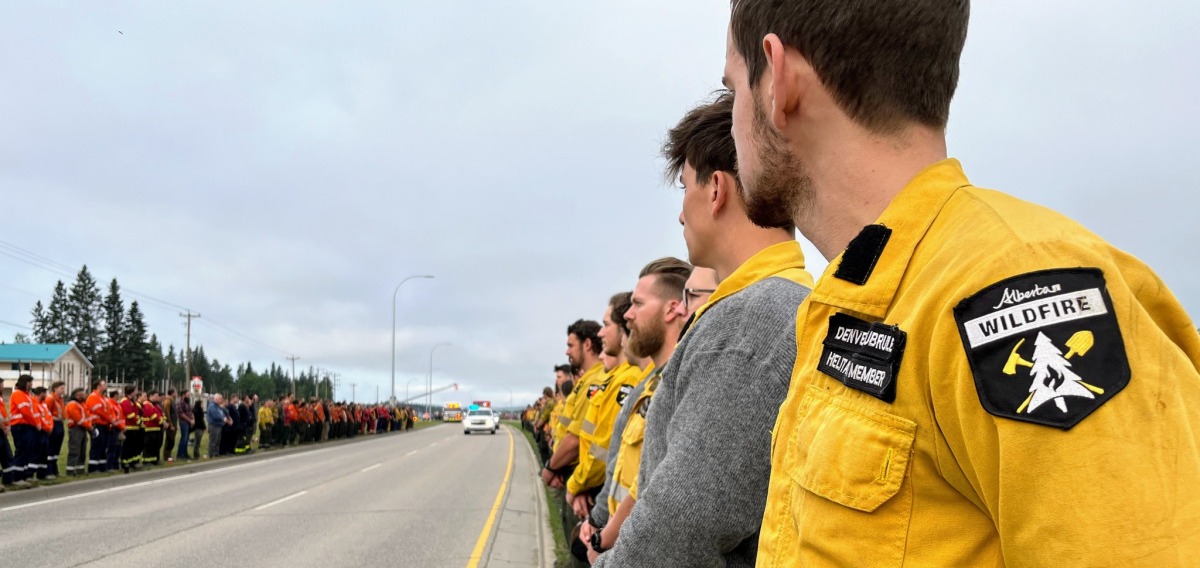
Fellow firefighters pay respects to firefighter killed August 3, 2024 fighting the Jasper wildfire.
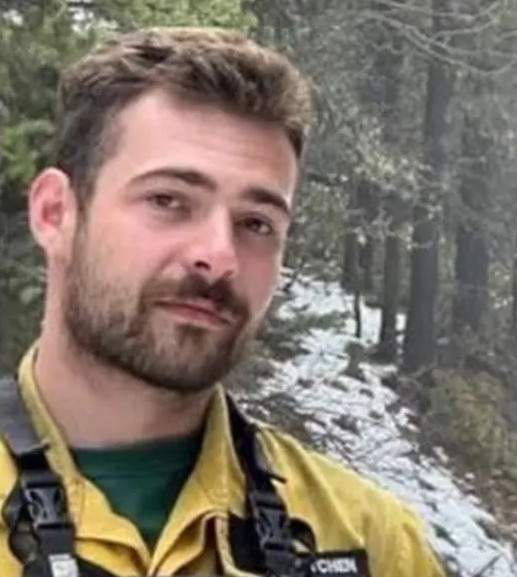 Morgan Kitchen, a 24-year old wildland firefighter, died on August 3
after being struck by a falling tree while battling the massive Jasper
wildfire. Kitchen, who had just turned 24 years old was from Calgary
and was based out of the Alberta Wildfire's Rocky Fire Base. He had
previously
served as a volunteer firefighter and was working his first season as a
wildland firefighter. Fellow firefighters and first responders showed
their deep respect and paid tribute to Morgan by lining the procession
route out of Jasper National Park as Morgan's remains left the park.
Morgan Kitchen, a 24-year old wildland firefighter, died on August 3
after being struck by a falling tree while battling the massive Jasper
wildfire. Kitchen, who had just turned 24 years old was from Calgary
and was based out of the Alberta Wildfire's Rocky Fire Base. He had
previously
served as a volunteer firefighter and was working his first season as a
wildland firefighter. Fellow firefighters and first responders showed
their deep respect and paid tribute to Morgan by lining the procession
route out of Jasper National Park as Morgan's remains left the park.
Morgan died fighting a fire of unprecedented scale which destroyed more than a third of the town of Jasper. In a statement issued August 19, Parks Canada said it was proud to say the wildfire was "held," meaning it is no longer out of control, on Day 27 of the blaze, especially because this was achieved on the day of firefighter Morgan Kitchen's memorial in Calgary. TML sends sincere condolences to the family and friends of Morgan Kitchen. Paying tribute to those who lost their lives requires action to prevent more such deaths.
Reports on Deaths of Firefighters in 2023
Eight firefighters died in the unprecedented wildfire season in Canada in 2023. WorkSafeBC has recently issued reports on two of these deaths. The reports cite multiple violations of the Occupational Health and Safety Provisions of the Workers Compensation Act. They provide proof that the safety of firefighters and the prevention of tragic workplace deaths require that the firefighters themselves exercise control over their working conditions, including wages and benefits.
Workers are well aware of how routine violations of safety protocols are normalized. Protocols exist on paper, but are routinely violated. Then when a tragedy takes place and a worker is injured or killed, the workers can be blamed for not following protocols.
Both reports pointed to a culture which normalizes risks around dangerous trees, despite the well-known danger posed and a documented history of failure to comply with requirements for dangerous tree assessments during firefighting operations. This is compounded when the "mainstream" media speak about how firefighters know the risks they are taking and that this is just "part of the job."
Devyn Gale was only 19 years old, but in her third season working for the BC Wildfire Service (BCWS) when she was killed when a burning tree fell on her. She was a third-year nursing student at the University of British Columbia Okanagan.
The WorkSafeBC report on Gale's death found no evidence that a dangerous tree assessment had been completed on the burning cedar at the site before the workers began their work, despite the fact that two firefighters had raised concerns about the tree. The report also identified gaps in the supervision of dangerous tree assessments and the training of young workers.
WorkSafeBC concluded that hazard management and supervision prior to the tragedy were "ineffective" and "inadequate" and that young, inexperienced firefighters were deployed to the area without sufficient training.
BC General Employees' Union (BCGEU) President Paul Finch released a statement in response to the report which concluded that, "...Processes like completing dangerous tree assessments and implementing safety training and orientation for new workers have fallen by the wayside due to an inability to retain experienced staff.
"The employer's failure to retain experienced staff means that many workers are put in dangerous situations. There is no substitute for experience fighting wildfires, and the Ministry needs to address the dire retention crisis currently facing BCWS. That starts with the Ministry reversing its current stated position that there is no retention issue among junior to mid level leadership positions, and working to take the appropriate steps to resolve the retention crisis."
Finch also pointed out that safety protocols are overlooked when staff are overworked, which is also a problem of recruitment and retention. More than half of all crew leaders in 2024 were in their first year in their position, he said.
WorkSafeBC also issued a report on the July 28 death of Zak Muise. Zak was working for contractor Big Cat Wildfire when he died in a utility vehicle crash in northern BC while fighting the massive Donnie Creek wildfire. He was 25 years old, and had come to BC from Ontario to work as a wildland firefighter. He was killed when the heavy-duty ATV he was riding in rolled over a steep drop on a gravel road in a remote area about 150 kilometres north of Fort St. John.
The report concludes that BCWS failed to adequately supervise the use of utility vehicles, lacked procedures and training about their operation and did not ensure they were inspected for safety.
For example, a netting system to keep occupants inside the utility vehicle in the event of a rollover was damaged and ineffective, something that would likely have been identified if a pre-use inspection had been carried out.
Wildfires are becoming more frequent, larger and higher-intensity. Treating wildland firefighting as a "gig" where low pay, minimal training, a transitory workforce, and seasonal work are the norm is highly irresponsible. Time and again it has been shown that it is the fight of the workers and their organizations to uphold safety standards which is decisive, otherwise even the existing protocols are not enforced. The safety of firefighters, of the Indigenous Peoples who are the most affected by fire in the forest, and all the communities in the forest and urban-forest interchange requires that decision-making be in the hands of the working people and Indigenous nations, not the forestry monopolies and governments which serve private interests. Putting the full weight of workers' organizations behind this issue can make a difference. All out to support the demands of the wildland firefighters for the conditions required for their health and safety!
(To access articles individually click on the black headline.)
Website: www.cpcml.ca • Email: editor@cpcml.ca

